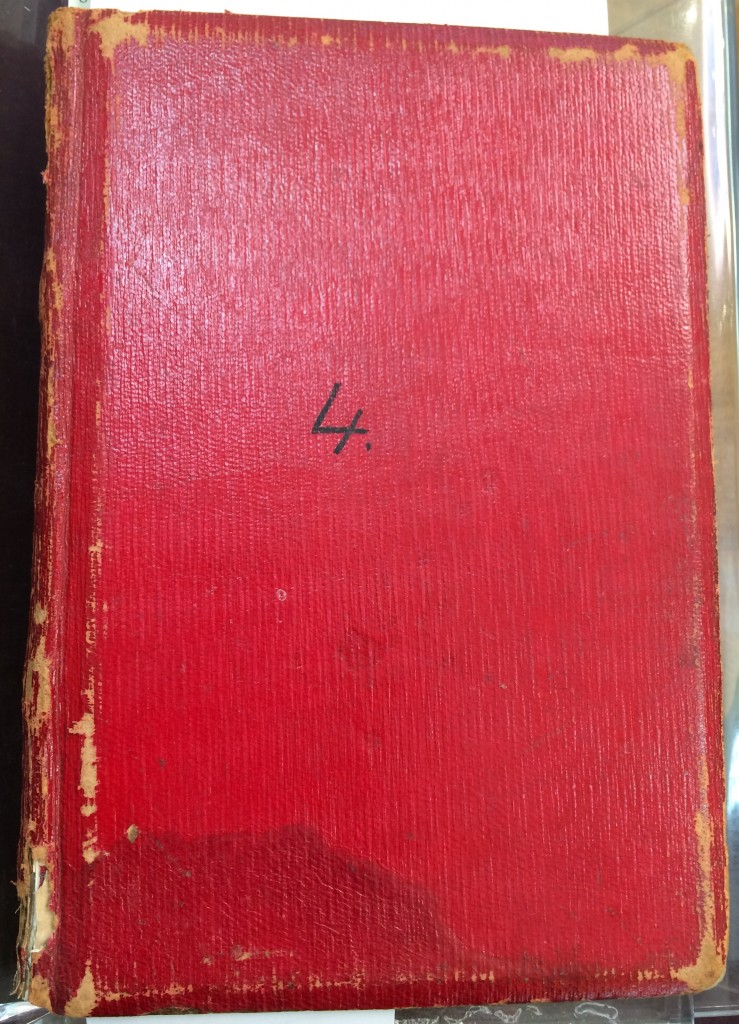 “Went to school in forenoon for the last time. Vacation! Vacation!! no school for three months,” begins the diary of twelve-year-old Marion (“Minnie”) Boyd Allen on June 15, 1875. This first entry—one which we would expect to find in a twelve-year-old’s diary now as then—is the perfect opening to a volume that proves to be as fascinating for its mundaneness as for its extraordinary in-depth look into the everyday life of what we now call a “tween” in the latter part of the nineteenth century.
“Went to school in forenoon for the last time. Vacation! Vacation!! no school for three months,” begins the diary of twelve-year-old Marion (“Minnie”) Boyd Allen on June 15, 1875. This first entry—one which we would expect to find in a twelve-year-old’s diary now as then—is the perfect opening to a volume that proves to be as fascinating for its mundaneness as for its extraordinary in-depth look into the everyday life of what we now call a “tween” in the latter part of the nineteenth century.
Minnie was born in Boston on October 23, 1862, to Stillman Boyd Allen (1830-1891), a lawyer, and his wife, Harriet Smith (Seaward) Allen (1831-1922). The Allens lived in the South End of Boston, which in 1875 was nearing the end of its heyday as a fashionable precursor to the Back Bay neighborhood that was then being built. Census records indicate that the Allens were well off, her father’s house being estimated at $50,000 and his personal property at $450,000 in 1870. Her diary paints a vivid picture of her comfortable upper-middle-class childhood, full of playdates with friends; games of croquet, billiards, and pitch; summers in Wolfeboro, New Hampshire, on the shore of Lake Winnipesaukee; and frequent trips out of the city to “Hillside,” most likely her grandparents Seawards’ place in Melrose, Massachusetts, where she climbed trees, jumped rope, and put on plays.
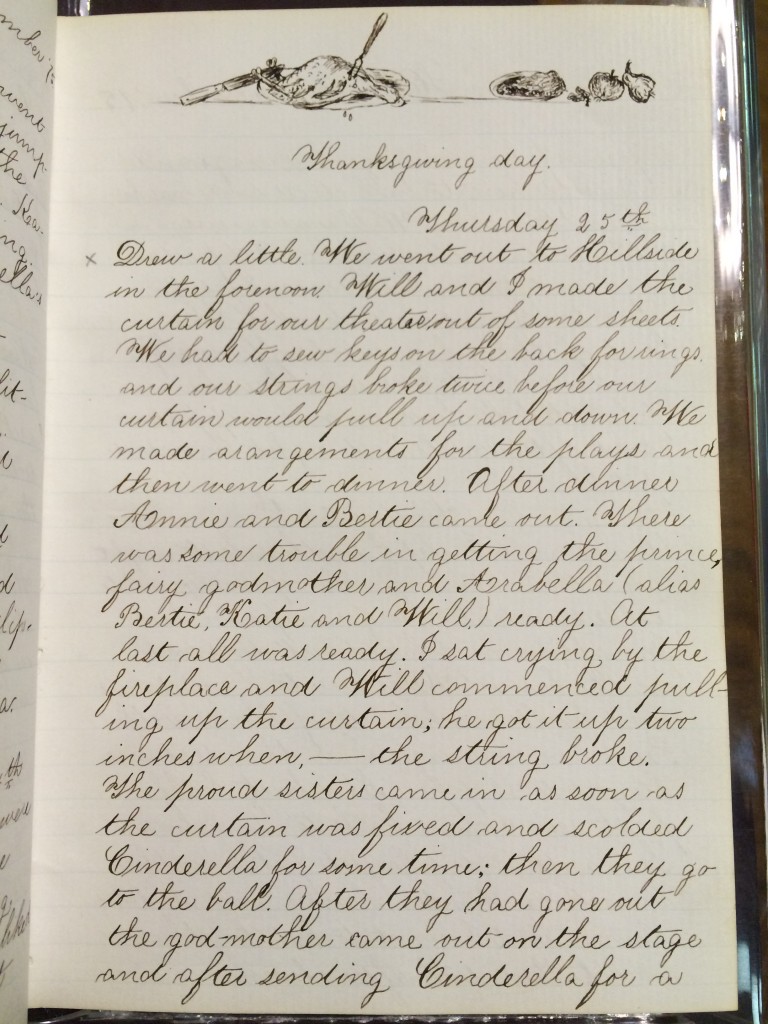 This last activity, which was common among the middle class of the period, was a particular favorite of Minnie’s for Thanksgiving celebrations. On Thanksgiving Day that November, Minnie—with the help of some cousins and her brother, Will, who was seven years her senior and a student at Harvard—presented a performance of “Cinderella” (with a script she adapted herself) to her gathered family. She and Will spent the morning setting up the stage, making the curtain out of some sheets and sewing “keys on the back for rings and our strings broke twice before our curtain would pull up and down.” She then had “some trouble getting the prince, fairy godmother, and Arabella (alias Bertie, Katie and Will) ready,” but “At last all was ready.”
This last activity, which was common among the middle class of the period, was a particular favorite of Minnie’s for Thanksgiving celebrations. On Thanksgiving Day that November, Minnie—with the help of some cousins and her brother, Will, who was seven years her senior and a student at Harvard—presented a performance of “Cinderella” (with a script she adapted herself) to her gathered family. She and Will spent the morning setting up the stage, making the curtain out of some sheets and sewing “keys on the back for rings and our strings broke twice before our curtain would pull up and down.” She then had “some trouble getting the prince, fairy godmother, and Arabella (alias Bertie, Katie and Will) ready,” but “At last all was ready.”
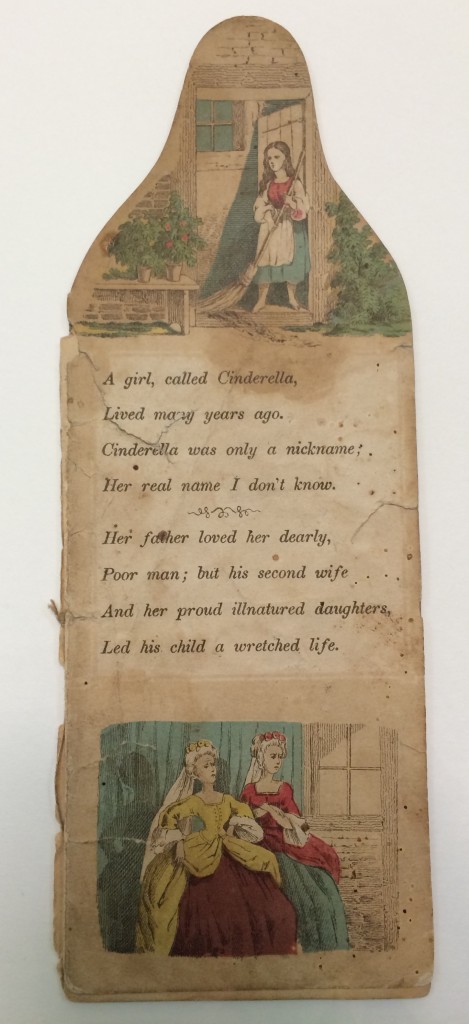
Minnie goes on to describe the plot of the play, the outlines of which remain unfailingly familiar to us today, and which Minnie would have known through the many iterations circulating the children’s literature market of her day:
I sat crying, by the fireplace, and Will commenced pulling up the curtain; he got it up two inches when,—the string broke. The proud sisters came in, as soon as the curtain was fixed, and scolded Cinderella for some time; then they go to the ball. After they had gone out the godmother came out on the stage and after sending Cinderella for a pumpkin, changes her rags and pumpkin into ball-dress and coach. One time as Will was raising the curtain, the fireplace tipped over and the candles nearly set fire to Grandma’s shawl. The rest of the play went off nicely and our spectators were much pleased.
Other than that pesky curtain that just wouldn’t seem to work properly and almost set grandma on fire, the play was a rousing success.
Accompanying this thorough description of Thanksgiving is a pen drawing that features a small, cooked turkey, a slice of pie, and what look like some fruits or vegetables (below). This small drawing, while cute and quite good for a thirteen-year-old, does not convey the true depths of Minnie’s talents. It is in fact a childhood doodle of one who would grow up to become quite a renowned portrait and landscape painter. In 1902, at the age of forty, Minnie entered the Boston Museum School, where she studied oil and watercolor painting under Frank W. Benson and Edmund Tarbell. In her sixties, she headed out West, where she painted the Rockies and the Grand Canyon. Her work was exhibited at the Museum of Fine Arts in Boston, the National Academy of Design in New York, the Pennsylvania Academy of Design in Philadelphia, and the Art Institute in Chicago, among other venues. Knowing the end of her story, these drawings in her diary, which she did for many holidays, take on an entirely new meaning.
Before becoming a professional artist, however, Minnie was in many ways a typical tween girl. The beginning of Minnie’s Thanksgiving the following year in 1876 sounds very familiar to our own. She “Got up at half past six and crimped my hair.” Dinner was served at 1 o’clock, at which “I don’t believe I ever ate so much at one time in my life.” But whereas our gluttonous dinners are bookended by parades of giant balloons and football games today, theirs was followed by an elaborate performance of “Mrs. Jarley’s Wax-works.”
A combination of tableaux vivant and monologues, “Mrs. Jarley’s Wax-works” was a take-off on a minor character in Charles Dickens’s The Old Curiosity Shop named Mrs. Jarley, who is the mistress of a waxworks show and helps Nell and her grandfather. One of the most popular renditions of the spinoff play was Mrs. Jarley’s Far-Famed Collection of Waxworks (1873), arranged by George Bradford Bartlett, a contemporary Concordian of Louisa May Alcott’s with whom she participated in amateur theatricals. Bartlett’s arrangement was often used to put on charitable fundraising events, and it’s very possible that Minnie saw it performed or read about it and now wished to recreate it.
Minnie’s performance of the play called on the talents of three generations:
Mrs. Jarley (alias Mamma) was truly magnificent in a dress with leg-o’-mutton sleeves and an enormous bonnet. Will was George. The first scene represented was “a villain disarmed by a smile.” Horace with a red table-cloth thrown over his shoulders, was the Villain. I was the Smile. How I ever kept my countenance I don’t see. I did it though. Then followed “Maid of Athens,” “Fat boy,”…“Indian pursueing [sic] the girl,” “Bo Peep” and the “Man who tickled his wife to death.” The crowning act of all however was “Jack Spratt and his wife.” Grandpa and Grandma took these parts beautifully and caused us much fun.
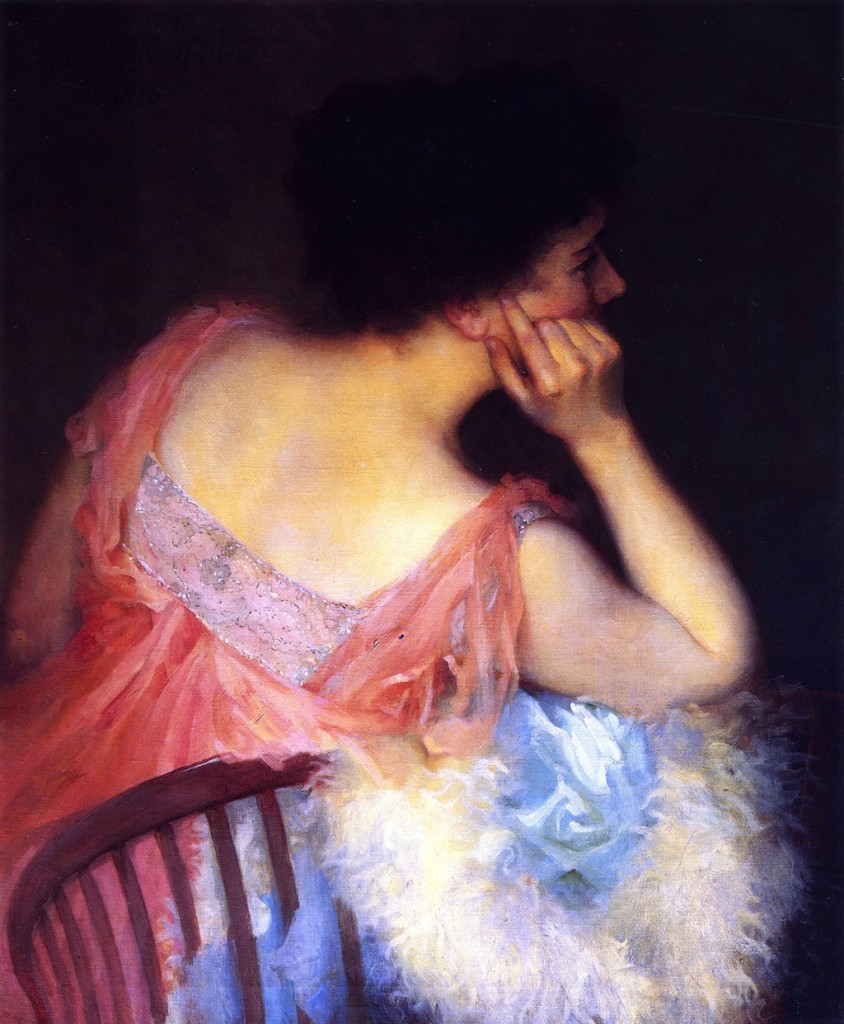
All in all, Minnie’s entry gives the sense of a loving family that’s game for anything, humoring the whims of the children and relishing the chance to dress-up and perform. (The questionable titles of some of these tableaux are another thing.)
And therein lay the magic I find in Minnie’s diary. Through her childish schemes, emotions, and recording of her daily activities, she makes her world come alive in an amazingly relatable way. Perhaps this is a consequence of having myself kept a thorough diary at this age, which, while painful to reread the awkwardness at times, I cherish. Or maybe it’s because Minnie’s upper-crust upbringing in the late nineteenth century reminds me of my first American Girl doll, Samantha, whose stories revolve around her strict grandmother’s Victorian mansion and summers on a lake. (Although set in 1904, Samantha’s fictional world bears a strong resemblance to Minnie’s real one of thirty years earlier.)
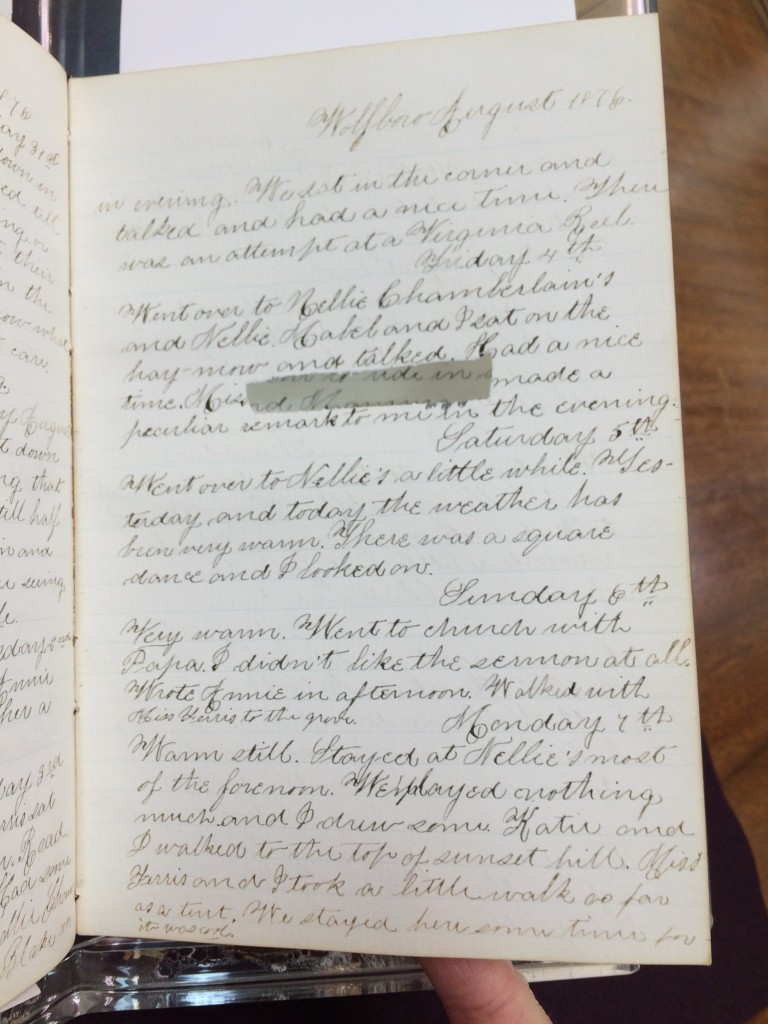
Or possibly it’s as simple as Minnie representing so many universals of girlhood. She concludes this Thanksgiving entry by writing that “After supper went over to Grandma Allen’s and had a pleasant evening. Slept with Annie. We went to bed at eight and to sleep at half past one.” In another instance, she wrote about a friend making “a peculiar remark to me in the evening,” but carefully cut out the friend’s name at a later date, leaving us to wonder who this “Miss” is.
Visiting multiple family houses on holidays, having sleepovers with friends (in her case a cousin) at which you stay up all night talking, and writing about disagreements with friends only to worry about someone reading it later—these are clear-cut memories of my own childhood. As was jumping rope until dark, climbing trees, and playing pitch. But I’ve never performed a play on Thanksgiving—perhaps it’s time to rethink that.
We’ll revisit Minnie around Christmastime, with more descriptions of lavish celebrations and drawings of decorations.


2 thoughts on “A Nineteenth-Century Tween’s Thanksgiving, 1875-1876”